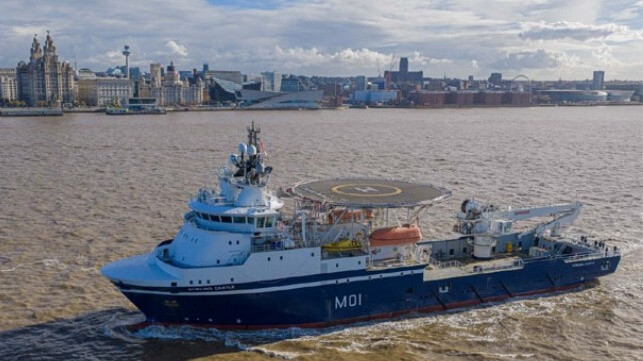Royal Navy Starts Trials with Repurposed PSV Transferred from RFA

The former commercial vessel that was repurposed in 2023 by the Royal Fleet Auxiliary as a “mothership” to host various autonomous minehunting systems has now resumed operations for the Royal Navy. HMS Stirling Castle sailed for the first time under the trademark White Ensign as a Royal Navy warship after a difficult period with the RFA.
The United Kingdom government acquired the ship in 2023 at a cost of $50 million from the Norwegian company Island Offshore. She had begun life as an offshore support vessel named MV Island Crown, built by Vard in 2013. Measuring 317 feet, the ship offered services in the oil and gas and wind sectors.
Following her acquisition by the Ministry of Defence, she underwent conversion at HM Naval Base Devonport, where she was transformed into a vessel dedicated to support mine hunting missions under the operations of RFA, a civilian-manned naval auxiliary fleet that provides logistical and operational support to the Royal Navy and Royal Marines.
Due to insufficient manpower as well as reports in the media of mechanical problems, Stirling Castle, however, only completed a few missions and spent much of her time idle. Navy Lookout reported in August 2024 she had been idled due to problems with her deck crane. In July 2025, she was formally commissioned into Royal Navy service.
According to the Royal Navy, the past four months have been instrumental in preparing the ship for her new role. Her 55 crew, alongside RFA personnel, are said to have worked tirelessly to prepare the ship for sea, conducting essential maintenance, safety checks, and training to ensure she was ready for operations. With those checks and sea safety training now complete, she was ready to take on her role in the Royal Navy as a minehunter.
“Taking Stirling Castle out of lay-up and getting her back into service in just four months has demanded extraordinary things from my team,” said Commanding Officer, Commander Phillip Harper. Stirling Castle, he notes, recently sailed for the first time for the Royal Navy. She is undertaking a series of trials and assessments, as well as conducting training.
When fully operational in the coming weeks, the ship is expected to significantly enhance the Royal Navy’s mine hunting capabilities. Specifically, she will be carrying high-tech equipment, including autonomous surface and underwater vehicles, for specialist mine hunting operations primarily in UK waters.
Stirling Castle was part of an effort launched by the Royal Navy to move away from traditional minehunting. A year ago, the Royal Navy disbanded its autonomous systems testing team and folded its functions into the fleet, ending a decade of R&D effort. Stirling Castle will now use cutting-edge technology and act as a mothership for an array of remotely operated and autonomous systems that will scour the vast UK waters looking for mines.
Later this year, Stirling Castle will undertake operational sea training, including with the vessel’s autonomous surface and underwater vehicles. Currently, the ship is still in her original blue and white colors, but the Royal Navy reports there are plans in the future to have the ship repainted in gray, the color of Royal Navy ships for more than a century.
